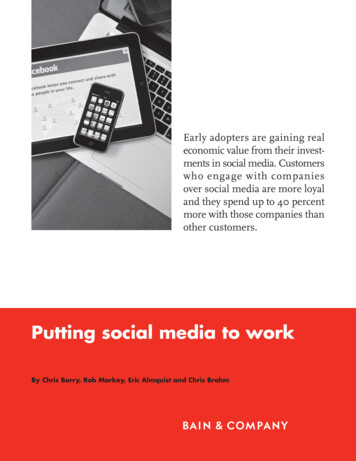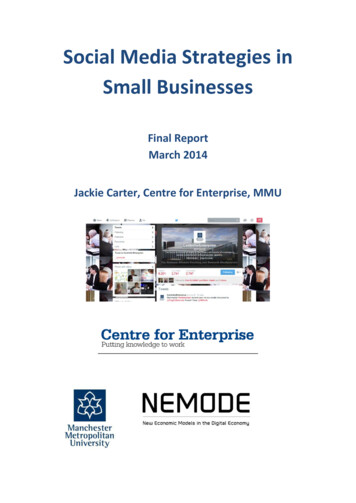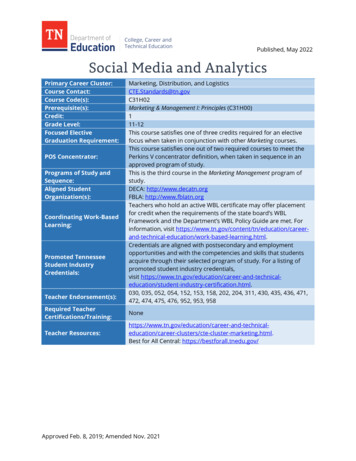
Transcription
Early adopters are gaining realeconomic value from their investments in social media. Customerswho engage with companiesover social media are more loyaland they spend up to 40 percentmore with those companies thanother customers.Putting social media to workBy Chris Barry, Rob Markey, Eric Almquist and Chris Brahm
Chris Barry is a partner in Bain & Company’s Los Angeles office. Rob Markeyand Eric Almquist are partners in Boston. Chris Brahm is a partner basedin San Francisco.Copyright 2011 Bain & Company, Inc. All rights reserved.Content: Global EditorialLayout: Global Design
Putting social media to workEarly adopters are gaining real economic valuefrom their investmentsin social media. Customers who engage withcompanies over socialmedia are more loyaland they spend up to40 percent more withthose companies thanother customers.Five years ago, few general managers outside ofthe tech industry had heard the term “social media.” As social networking services such as Facebook and Twitter broke loose on the mainstreambusiness scene, the majority of companies stoodon the sidelines trying to make sense of it all.Despite the proliferation of corporate Facebookpages and Twitter accounts during the last coupleof years, most businesses still effectively remain onthe sidelines. The gap between the early adoptersand those waiting to take the plunge has actuallywidened. While the average billion-dollar companyspends 750,000 a year on social media, accordingto Bain & Company analysis, some early adopters such as Dell, Wal-Mart, Starbucks, JetBlue andAmerican Express invest significantly more. Insome instances, the investment is tens of millionsof dollars. Who is right—the early adopters orthe companies still waiting it out?Our research shows that several early adoptershave captured real economic value from theirinvestments. But the social media scene is so turbulent and frothy that many others have pouredgood money after bad in their attempts to engagecustomers. The leaders typically employ the sametried-and-true business principles—refined throughtraditional marketing, service and operations—applied in new ways. While they often experimentand sometimes fail, they don’t allow themselvesto fall into the trap of thinking that somehow“everything has changed” in this new world.As part of a broader customer engagement strategy,social media can be an effective and cost-efficientmarketing, sales, service, insight and retentiontool. Our recent survey of more than 3,000 consumers helped to identify what makes social mediaeffective. We found that customers who engagewith companies over social media spend 20 percent to 40 percent more money with those companies than other customers (see Figure 1). Theyalso demonstrate a deeper emotional commitment to the companies, granting them an average33 points higher Net Promoter score (NPS ),a common measure of customer loyalty (seesidebar, “NPS 101”).Embracing empowered consumersMore than 60 percent of Internet-connected individuals in the US now engage on social mediaplatforms every day. The speed and access to information that they’ve come to appreciate has madethem more demanding customers. For example,many now expect real-time customer servicerecovery and quick responses to their online feedback. Hyper-connected individuals regularlybroadcast their opinions. And they rely on theirfriends and social networks for news, reviews andrecommendations for products and businesses.Social media leaders understand and appreciatethe magnitude of the shift in customer empowerment and the opportunities and risks that thesetools create. As a result, they approach their socialmedia efforts differently. While the average company may maintain Facebook and Twitter accountsand have other discrete programs run by theirmarketing or customer service teams, in our experience, these efforts tend to be uncoordinated, withdifferent business units, brands or geographiesconducting their own social media experiments.1
Putting social media to workFigure 1: Engaged customers spend moreEngaged customers spend 30% moreAnnual average spend (indexed to Promoter 100)150 30%100 40% ce: Social Media Consumer Survey (January 2011), n 3,019By contrast, the leading firms invest significantlymore. They pursue integrated social media strategies, with a more holistic assessment of the valuethat social media can create across the businesses,and with efforts directly tied to strategic businessobjectives. As the early adopters continue to invest,their peers take different approaches. Some feelthat they have social media at least partially sortedout with their Facebook pages and Twitter accounts.But others are beginning to ask more questions: What is the business case for investing further in social media? Where and how muchshould we invest?Fundamentally, how much is consumer behavior changing? What are the biggest opportunities and threats? How aggressively aremy competitors investing in these tools, andare they capturing differential advantage? Should we build or buy our own “community” or partner with one of today’s leadingplatforms? Or both? Where should weplace our bets? How should we organize and coordinate ourefforts? Across brands? Across businessunits? Across geographies? How should we measure results? Howdo we know whether we are creating realbusiness impact?While no one can say for sure how social mediawill evolve, and no one can know which platformswill ultimately endure, the long-term winnersare likely to take a systematic approach basedon five key principles:1. Link social media efforts to concretebusiness objectives 2What are the best practices in deployingsocial media strategies? What are the pitfalls to avoid?The roadmap for a successful business-toconsumer social media strategy starts first and
Putting social media to workNPS 101One effective way to measure the effect of a social media program on customer loyalty iswith the use of a Net Promoter system.To start out, one should measure a Net Promoter score (NPS) by asking customers the question:“How likely would you be to recommend [this company or product] to a friend or colleague?”Respondents who give marks of nine or 10 are promoters, the company’s most devoted customers.Those scoring their experience seven or eight are passives, and those scoring it from zero tosix are detractors. NPS is the percentage of promoters minus the percentage of detractors.After ranking customers, companies create a closed-loop system to learn why customers arepromoters, passives or detractors, and to deliver the feedback directly to employees who canact on that feedback. When appropriate, they follow up directly with customers.Companies make it a priority to increase the number of their promoters and shrink the numberof their detractors, discovering and investing behind the actions that improve the company’s NPSin ways that are financially sound and that will result in profitable, sustainable, organic growth.foremost with understanding the full value thatsocial media can create as one tool in a broadercustomer engagement strategy.Social media shouldn’t be viewed as a mere channel for marketing or public relations or as simplyan effective customer service tool. While manycompanies started out using social media to getthe word out about products, the most successfulhave significantly expanded their efforts to engagetheir customers at every step of what we call the“customer corridor,” touch points that start whena potential customer first learns of a product andextend through the moment they opt to makerepeat purchases. Improve the product or user experienceby embedding social capability; examplesare social gaming, social television andsocial shopping Wow customers with real-time service response, recovery and technical support, withgreater efficiency than traditional channels Capture torrents of consumer insights, andfacilitate consumer-led innovation Build community and affinity throughengagement, earning greater loyalty, spending and referrals Generate awareness at a fraction of thecost of traditional advertising media andenable hyper-targeted marketingSeveral companies have registered real bottomline results from their social media efforts (seeFigure 2). Most impressive, however, are thecompanies that have stepped back and deployedholistic social media strategies aimed at unlocking value at each stage of the customer corridor. Prompt trials with daily and increasinglyreal-time, location-based promotionsConsider Dell and its broad use of social media.Dell’s current social media efforts grew out of theSocial media can create value at each step alongthe way to:3
Putting social media to workFigure 2: Companies using social media to serve the needs of customers can achieve realreturns at every touch pointAwarenessFord achieved same level of brand recognition with a Fiesta social mediacampaign at 10% of traditional TV ad costWet Seal reports that social shoppers have a 2.5 times greater conversion ratePurchasethan the average customerNike product and social community credited with increasing Nike running shoeUsemarket share from 48% to 61%Intuit’s own QuickBook customers answer 70% of fellow customer service questions onlineServiceLEGO credits customer ideasourcing with its decision to launch more expensiveFeedbackRetentionand customer innovated sets, such as the 500 piece Star Wars producteBay community users spend 54% more than other customersSources: Industry publications and websites; Bain analysiscompany’s customer-centric and direct sellingmodel, founder Michael Dell’s foresight of thepower of online social engagement, and some infamous prodding on technology blogs. Broughtto life as a way to respond to customer serviceissues, Dell’s social media efforts expanded inmultiple directions, helping the company increase revenues and retain loyal customers. Toboost sales, the company’s Dell Outlet site offersflash promotions through Twitter. The computermaker uses feedback generated on social mediato improve its products and customer service:Direct2Dell facilitates active dialogue between customers and company leaders, while itsIdeaStorm.com enables crowd-sourced ideas andgives customers the opportunity to collaborateand prioritize product and service improvements.Finally, the company relies on social media toactivate promoters and acquire new customers:@Dell interacts with potential customers—andalso facilitates promoter interaction with potential customers. End-to-end, social media is a keytool in Dell’s customer engagement strategy.42. Focus and tailor your efforts to engageyour key customersWinning companies have learned that, while aneffective social media strategy can reap big rewards,it also isn’t something that happens easily. It isobvious to many companies now that you can’tjust put up a Facebook page and start broadcasting content. You can’t take for granted that fanswill just stick around and allow their walls to befilled with marketing and promotions.Bain & Company research shows that the averageFacebook user will “like” no more than sevencompanies or brands. Facebook users must beselective or they will soon find their walls flushwith corporate messaging and promotions, leaving little room for posts by friends and family. Toincrease the odds of capturing valuable real estate on a customer’s wall, it is critical to knowyour target audience and understand which socialmedia platforms they frequent, as well as thetype of content and engagement they find most
Putting social media to workcompelling. Only then can you optimize yourplatform mix and tailor your content to reachthose customers.Our research has identified 10 segments of socialconsumers (see Figure 3). Members of thesesegments frequent different social media platforms and prefer different types of content andengagement models. For example, companiessuch as Disney, Wal-Mart and Mattel, who target“moms,” will find they are disproportionately“Social Butterflies” and “Social Gamers.” A keydemographic on Facebook, “moms” as a groupspend significant amounts of time playingsocial games. Companies such as Nestlé havefound ways to embed their brands into thegames that moms play online. For example, thecompany allows users to grow ingredients of itsStouffer’s brand prepared meals within theFarmVille game. It engages with key customers in the right platform, and with the contentthose customers find compelling. Alternatively,companies looking to capture the online attentionof the “Young and Mobile” will reach them throughmicro-blogs and location-based games, makingthe most of the platforms that are popular withthis segment. As the social media ecosystem continues to evolve, it will likely further fragment,making consumer segmentation—and tailoredsocial media approaches—even more important for success.In addition to tailoring efforts to key customers, companies need engagement plans thatexplicitly target their promoters and detractors,as well as key influencers. Promoters are a company’s natural fans, though our research showsthat a company’s Facebook fans and Twitterfollowers are actually a mix of promoters, passives and detractors.Most companies dread the vocal and influentialdetractor. Social media offers these unhappycustomers a platform from which to quickly broadcast their negative commentary. Companies suchas JetBlue and Dell, who actively monitor socialFigure 3: Who’s online? Design the social strategy with target consumers in mindBain’s social media consumer segmentation18%12%12%11%10%Social ButterfliesFact FindersContributorsBlog ReadersObservers Heavy users of Heavy users ofpersonal networksmultimedia sites, Skew to female users,ratings and reviewyounger and workingsites, branded “Moms” represent acommunitieslarge share Skew to maleusers, older Moderate social Disproportionatemedia use andcreators and postersdisproportionateof contentpresence on blog sites Heavy users oflocation based games, Skew to maleusers, oldercrowdsourcing sites,branded communities,social shopping Maintain passivepresence on socialnetworking sites Skew to femaleusers, older10%9%8%6%4%Deal HuntersYoung and MobileSocial GamersShowgoersProfessional Networkers Heavy users of ratings Heavy users of Active on socialand review sites,gaming andmicroblogs, socialgroup buying sites,engaged in location networking andbranded communitiesbased gaminglocation based games Disproportionate Significant contingent Skew to youngershare of spendingskews olderdemographics,occurs onlinee.g., students Tend to be passiveconsumers ofentertainment andcontent generatedby others Heavy usersof professionalnetworking sitesand microblogs Skew to maleusers, affluentSource: Social Media Consumer Survey (January 2011), n 3,0195
Putting social media to workMaking the business case for social mediaMany companies struggle to calculate an ROI on their investment in social media. And withoutconfidence in clear returns, have difficulty securing the funds needed to scale their efforts. Companies that most successfully make the business case for social media use a two-pronged approach.First, they set clear business objectives for using social media at each step across the customercorridor. They run small, contained pilots, carefully tracking returns to demonstrate whether further investment is warranted. For example, if the objective is to generate leads, the same metricsand measures used to assess the effectiveness of other marketing vehicles can be deployed togauge the success of a social media pilot campaign. If the objective is to boost customer service,the effectiveness can be measured by service resolutions, relative cost and productivity, callavoidance and the ratios of detractors converted to promoters.Second, companies further build the case by considering the broader value of social media.They articulate the value of engaging their customers where they are increasingly spending timeand consider the real business value that authentic engagement can create. Again, customerswho engage with companies over social media are more loyal and they spend 20 percent to 40percent more with those companies than other customers do. Social media platforms are becoming increasingly important for companies to engage with, delight and retain their best customers.chatter, engage detractors on a real-time basis inan effort to diffuse heated commentary. In thebest outcomes, they successfully convert thosedetractors to promoters. Dell estimates that itscustomer service teams can convert a detractorto a promoter more than 30 percent of the time.JetBlue’s real-time Twitter customer service recovery force received much attention for its adepthandling of last December’s “Snowmageddon.”JetBlue effectively converted stranded passengersfrom detractors to promoters by quickly rebooking them on new flights. And these successfulrecovery efforts were witnessed by JetBlue’s 1.6million Twitter followers. Stories of the exceptionalrecovery reverberated broadly across the Web andbeyond, as traditional media outlets picked themup. JetBlue estimates that its customer servicerecovery over Twitter is more productive thanwhen delivered over alternative channels and thatit can handle five customer-related tweets for everyone call handled through a call center. As thecompany’s successes have grown, it has continued to invest further in its Twitter-enabled customer service team.6Social media leaders also think just as carefullyabout how they can effectively nurture and mobilize “Influencers”—those hyper-connectedindividuals who have disproportionate onlineclout. Companies such as Microsoft, Dell, andProcter & Gamble host events for Influencers,provide special online recognition, allow themto try and test products, and host online chats.They invest in the Influencers to magnify theimpact of their engagement efforts.3. Build a social media organization todeliver resultsOnce a company has linked its approach to business strategy and targeted its key customers, itneeds to put in place an organization to followthrough—an organization that’s designed toenable coordination and share best practices.Winning companies mobilize cross-functionalteams spanning marketing, sales, public relations,corporate strategy, customer service, productdevelopment, IT, HR and legal.
Putting social media to workMany companies today have social efforts siloedacross functions. Leaders align their organizationsto more effectively coordinate and communicate.Why is this important? First, it allows the entire organization to learn from each customer touch point.Second, it better enables the company to deliver aconsistent and seamless customer experience.While the organization must ultimately be definedby a company’s unique social media strategy,we’ve seen three successful organizational modelsdeployed to coordinate social media efforts: Empowered units. Dell is a great exampleof a company with an empowered unit structure. Within this type of organizationalmodel, the social media strategy is managedby a cross-functional team that can be staffedvirtually or centrally—or a combination of thetwo. The head of the social media organizationholds responsibility for integrating the vision,coordinating strategic initiatives and definingmetrics and dashboards. Each function deploys its own social initiatives but circles backto the group with insights and best practices.Command and control. Starbucks’ social media strategy is deployed by a single, centralsocial media organization. Such a team mayexist within a function or as an independentteam under corporate. That approach allowsfor strong centralized control of consistentbrand messages and customer experiences.Decentralized. Zappos and Best Buy bothdeploy social media in a decentralized fashion.In this model, a small central team coordinates the efforts of numerous employees whoindividually engage with customers via socialmedia. Many companies deploying such amodel report that empowering employeesincreases morale and retention. With thismodel, it is especially important to deviseand communicate clear social policies andprocedures in order to manage risk to thebusiness and brands.Leaders also look for ways to capture the greatestscale benefit from their investments in organization and tools. Social media organizations tendto grow as companies prove they are achievingbenefits. While most companies build the socialmedia organization initially to engage their customers, they often find that they can also usethese same social teams and platforms to engage their own employees and their partners.4. Monitor and measure the results—thenclose the loopCreating the right dashboard to measure andtrack results is critical. There are a few challengesin measuring the return on investment (ROI) onsocial media efforts, and many companies willremain gun-shy about spending until they capture concrete evidence of ROI (See sidebar,“Making the business case for social media”).Leaders are quickly evolving their monitoringand measurement approaches. They are investingin the tools and methods to better integrate andconnect social conversations, Web analytics, customer records and purchase data. The aim is toboth improve the effectiveness of their social campaigns and to better capture the data needed onleads and conversion to calculate financial returns.Generally, companies should think about measuring performance and tracking results inthree key ways: Engagement metrics. Companies find it valuable to track the percentage of customers“engaged”—looking at such basic measuresas site traffic, fans and followers. Additionalengagement metrics include buzz and shareof voice. While most companies rely on thirdparty analytics firms to capture these metrics,leaders such as Dell and Gatorade have invested in their own social media listeningcommand centers. Within these centers, employees complement social media monitoringsoftware with a dashboard of key metrics such7
Putting social media to workas brand discussions, customer interactionsand media campaign performance. Thesedashboards emphasize the role of listening asan organizational priority, and better enablecompanies to spot important trends quickly. Customer metrics. Social media leaders invest in the tools necessary to track shifts inloyalty and NPS. They also invest in themanual “cleaning” of listening and analytictool output to capture shifts in sentiment.Social analytics providers are still developingtheir machine-based algorithms to bettercapture sentiment trends, which are difficultto obtain with natural language translation(see sidebar: “A caution on sentiment analytics”). We expect that these firms—alongwith the broader set of social engagement,social management and social intelligencesupport tool providers—will continue to invest to improve their tools. We also expectfurther consolidation in this space as themarket continues to evolve and mature. Financial impact. Leaders aggressively capture personal identifiers to link social mediaprofiles and associated behavior to customerrecords databases. Contests and promotionsthat require registration of email addressesand Twitter “handles” help bridge socialidentities. Once the connection is made,companies can more easily track leads, conversion and ROI on social campaigns.In addition to measuring the success of social media efforts, those companies that trulyextract value from social media “close theloop.” They take the torrents of consumerinsights captured via social engagement andrelay them back to the product and customerservice teams. It is this closed loop that allowscompanies to strengthen the underlyingbusiness value proposition. Ultimately, thatis how social media delivers long-term,sustainable value.5. Be flexible and adaptive. It’s stillearly daysSocial media is one area in which everybody islearning in real time. Just as companies need tocontinuously experiment to determine what worksfor them and their customers, they also need tonegotiate an increasingly crowded playing field,with newcomers always joining the game. Thecompanies that succeed will be those that areflexible and adaptable. They’ll be able to quicklytry new approaches and just as quickly adjust—or abandon them. They’ll listen to social consumers and relay their findings back to product andservice teams to strengthen the company’s underlying value proposition.These still are the early days and we expect the gapbetween social media leaders and others to continue to grow. Consumer behavior will continue toevolve. New applications and social platforms willproliferate and enable even greater personalization and real-time, location-based engagement.Today’s social media winners won’t necessarilybe tomorrow’s.But amid the continuous disruption of a rapidlyevolving game, companies that link social mediato business objectives, target and tailor their engagement to key customers, build a coordinatedorganization, track results and close the loop, andstay flexible will significantly increase their oddsof capturing real value from social media.Net Promoter and NPS are registered trademarks of Bain & Company, Inc., Fred Reichheld and Satmetrix Systems, Inc.8
A caution on sentiment analyticsCompanies considering hiring social media analytics firms should be advised that this scienceis in its infancy, with serious limitations. Machine-based analytics tools can measure the volumeof posts, but they face significant challenges in accurately capturing sentiment. Raw online datamay be full of misspellings and gibberish. Natural language is full of sarcasm and slang. Assuch, time-intensive manual manipulation is still required to accurately assess consumer sentimentand capture consumer pain points. Such limitations have prevented analytics companies fromliving up to their potential. One strong signal that they fall short: while most industries achievean NPS of about 30 percent, the nascent social media analytics industry scores a - 60 percentNPS, according to Bain research.While we expect this young industry to consolidate and improve with further investment intools, few customers of these companies today are promoters.
Bain’s business is helping make companies more valuable.Founded in 1973 on the principle that consultants must measure their success in termsof their clients’ financial results, Bain works with top management teams to beat competitorsand generate substantial, lasting financial impact. Our clients have historically outperformedthe stock market by 4:1.Who we work withOur clients are typically bold, ambitious business leaders. They have the talent, the willand the open-mindedness required to succeed. They are not satisfied with the status quo.What we doWe help companies find where to make their money, make more of it faster and sustainits growth longer. We help management make the big decisions: on strategy, operations,technology, mergers and acquisitions and organization. Where appropriate, we work withthem to make it happen.How we do itWe realize that helping an organization change requires more than just a recommendation.So we try to put ourselves in our clients’ shoes and focus on practical actions.For more information, please visit www.bain.com
the magnitude of the shift in customer empower-ment and the opportunities and risks that these tools create. As a result, they approach their social media efforts differently. While the average compa-ny may maintain Facebook and Twitter accounts and have other discrete programs run by their marketing or customer service teams, in our expe-










